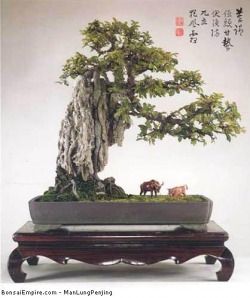Chinese Bonsai: 5 (Good) Reasons to Look Into It

Have you heard about Chinese bonsai yet? This ain't your typical, difficult "tree in a pot" stuff. The Chinese style of bonsai is different in many ways. Here are 5 good reasons to check it out!
1) It's less demanding than the Japanese style. Where Japanese bonsai usually involves a simple tree in a pot, styled according to very specific rules, Chinese bonsai tends to let you be more free-wheeling in your designs. The main idea is to capture the "natural" look of a tree... only in miniature scale. Traditional Chinese bonsai trees were styled according to the designer's whims, and they could even be "ugly" as long as they were also good conversation pieces. This is a great way to start creating your own bonsai, allowing you to be creative without getting too intimidated by strict rules and forms.
2) You can have a ton of fun making tiny landscapes. One of the main differences between Japanese and Chinese bonsai is that Chinese bonsai often involve little props (like houses, animals, and people) that are small enough to make the tree look like it’s part of a landscape. Seriously, have you seen some of the beautiful scenes that have been created with small trees? You can see an example on the left. It's like a mini version of a scene on a postcard from somewhere in Asia. You can do this too! (See reason #1.)
3) It's modern bonsai's great-granddaddy! Chinese bonsai was originally called "penjing" and the earliest records date more than 1,000 years ago. By learning more about the ancient origins of bonsai, you’ll have a better understanding of the art form as a whole.
4) Accomplishment. In this day and age where many of us work on paper instead of with our hands, where our worth is measured in money instead of the physical fruits of our labor, it's nice to have something concrete that you can point to and say, "Hey, look at what I made." The long process of training a tree to look awesome in a small pot will give you something substantial to work towards.
5) It's sexy. If you met someone of your preferred gender who was really into bonsai, you'd be pretty intrigued, right? Let's face it: we usually associate bonsai with a state of zen-like calm, plus the uncanny ability to exert amazing physical power without much effort. That's hot!
You can find out more about Chinese bonsai at http://www.chinesebonsaiblog.com!
